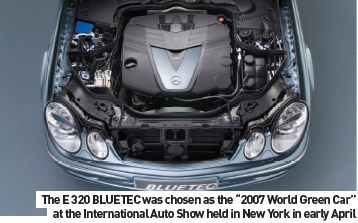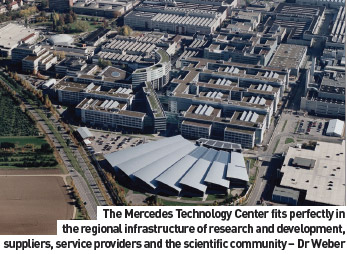
When it comes to the latest progress in hybrid technology at Mercedes-Benz, Dr Thomas Weber is the man with his finger on the pulse
DaimlerChrysler (as was) has been at the forefront of alternative powertrain vehicles for over a decade – the pioneers of the high-speed passenger car diesel engine have shown many non-oil powered automobiles in concept and in working prototype form.
While many people believe that with safety so high on the agenda, weight savings in body/chassis may have peaked, Thomas Weber has a more holistic approach. This is perhaps due in part to his background: several years as plant director/ manager at various DC facilities, plus production planning posts, means he has covered a broad spectrum of jobs.
Simon Duval Smith: Which alternative powertrains are you working on most – hybrid, fuel cell, others?
Thomas Weber: DaimlerChrysler offers a broad spectrum of alternative powertrain systems to ensure future sustainable mobility.
 We are working on further increasing the efficiency of drive systems and vehicles. Our most important aim in the short to medium term is to further optimise today’s gasoline and diesel engines so as to make them even more economical and cleaner.
We are working on further increasing the efficiency of drive systems and vehicles. Our most important aim in the short to medium term is to further optimise today’s gasoline and diesel engines so as to make them even more economical and cleaner.
Our strategy is to make the diesel as clean as the gasoline engine and the gasoline engine as fuel-efficient as the diesel engine.
Diesel cars are not only economical; when coupled with our BLUETEC modular exhaust gas treatment system, they are also very clean. The E 320 BLUETEC was chosen as the “2007 World Green Car” at the International Auto Show held in New York in early April. This award honors the E 320 BLUETEC as the pacemaker of a new, very low-exhaust diesel technology. We will introduce our E-Class BLUETEC model to Europe next year.
As far as gasoline engines are concerned, we will soon be offering second-generation spray-guided direct injection in the E-Class based on the system we‘ve already introduced in the CLS 350. This technology will later be extended to other model series as well. Downsizing and supercharging are two other engine-related techniques that we continue to work on extensively.
We are also forging ahead with the development of a set of innovative hybrid modules, which will be tailored to a wide variety of vehicle and customer requirements. We will not develop any new vehicles that do not also allow for the hybrid option. We will be offering the first hybrid systems next year. Other important issues we are working on are energy management, lightweight construction and friction reduction.
For the long term we are vesting our confidence in fuelcell drive. It is not only environment-friendly, but also highly efficient. It runs on hydrogen, and its intrinsic efficiency factor is double that of the internal combustion engine. Furthermore, hydrogen can be transported over long distances or even generated directly at the filling station.
DaimlerChrysler is the pioneer of this key technology: we presented the first fuel-cell vehicle in 1994. We now have the largest fuel-cell fleet on the road of any manufacturer, with more than 100 vehicles.
After all, only in combination with sustainable fuels and the necessary infrastructure can major improvements in fuel consumption and emissions be achieved. This is why we are preparing our engines for the use of alternative fuels, for example, our “biomass to liquid” (BTL). They are CO2- neutral and can be used without modification in any diesel vehicle.
SDS: Are you looking for involvement from engine/ powertrain suppliers in innovation and development? Are you looking for them to make big investments to produce very specialised pieces for hybrid/fuel cell/electric drivelines for instance?
TW: Cooperative arrangements between manufacturers and suppliers are becoming increasingly important in an intensely competitive environment with limited growth.
 This cooperation with powerful partners from the supplier industry opens up new opportunities for integration of innovative systems and components in vehicles at prices in line with the market. Important influencing factors on our target-oriented developments arise not only from monitoring the competition but also, of course, from impulses arising from the close cooperation with partners from the supplier industry and their expertise, as well as from observing the scientific community.
This cooperation with powerful partners from the supplier industry opens up new opportunities for integration of innovative systems and components in vehicles at prices in line with the market. Important influencing factors on our target-oriented developments arise not only from monitoring the competition but also, of course, from impulses arising from the close cooperation with partners from the supplier industry and their expertise, as well as from observing the scientific community.
We have a global supplier and vendor network that is capable, innovative, flexible and competitive. The importance of the supplier industry is tremendous and has grown in recent years. Outsourcing of development activities to the supplier increases. Therefore, we call on the German industry to cultivate their know-how on the technologies of the future and to increase their expertise, for example, with regard to power electronics and battery technology.
SDS: With complexity and sophistication higher than ever in engine/powertrain production, do you plan to keep hightech engineering and production in West Germany or can you see some complex and innovative work going out to low labour cost countries? If so, where?
TW: DaimlerChrysler is committed to Germany as an industrial location. It is one of Germany’s largest industrial employers. The expansion of the Mercedes Technology Center is a good example.
Development, compact know-how, focused resources, close networking of research with the individual business units, and rapid, efficient transfer of innovations into marketable products are crucial factors in successful global commitment.
The Mercedes Technology Center constitutes the core of our research and development activities. While overall vehicle development is concentrated in Sindelfingen, where the vehicle production is located, we have united all functions concerned with engine and powertrain development in Untertürkheim; our powertrain production is based there. This leads to more concentrated technical competence for the brand.
The Mercedes Technology Center fits perfectly in the regional infrastructure of research and development, suppliers, service providers and the scientific community.
Outstanding conditions prevail here locally: from a company internal perspective we can access our worldwide knowledge network, on the one hand, supplemented by the local connection (short paths) to production, planning, and such like, on the other hand.
By expanding the Mercedes Technology Center with the new “Mittelpfad Sindelfingen” we’ve given a clear signal for the future viability of Stuttgart, Baden-Württemberg and Germany as automotive industrial locations.
SDS: Which parts of the car do you see as making sense in terms of commoditisation – which parts could you mass produce in one location and then ship around the world?
TW: We already work on the basis of a common set of modular building blocks. That allows us to reduce the complexity and therefore the expense (in terms of time and money) while at the same time permitting us to guarantee top quality and high customer value. We will further extend this development in the future.
As a result of this module strategy and standardised vehicle architecture, far fewer sunroof variants, for example, are used. Vehicle roofs may differ in their contours and shape, but they are designed in such a way that standardised parts and modules can be used in multiple series and can easily be produced and installed in vehicles. The same goes for the design of exterior mirrors, for example. Instead of the ten mirror head variants used in the past, only four variants are used across all series. This also applies to new technologies such as BLUETEC, which can be shared.
We also verify and develop new vehicle architectures, considering that common approach must deliver an additional value. But can be sure that the brand autonomy won’t be touched and the individual character of each class will be obtained – that is top priority.
Part of our essential area of expertise has always been to offer our customers a greater range of options and technically sophisticated solutions than other manufacturers.
Our intention is to continue to do that in the future – to a reasonable degree and at competitive cost. We will focus more attention on innovations that the customer can actually experience and feel.
SDS: In UK, we have a law that allows very light cars to be classed as quadricycles – four-wheeled motorcycles. This has led to problems with light electric cars not being able to pass any crash tests. Which materials and construction techniques will come to the front in making lighter, safe cars?
TW: One thing is for sure – we will not just use any kind of materials on account of our safety imperatives. Safety has a long history at DaimlerChrysler – it always was a high priority topic. Customer requirements with regard to safety, efficiency and clean power engines must be reconciled with individualization of the driving experience. At the same time, the political demands and the demands by consumers for enhanced vehicle safety must be accommodated; but this increases a vehicle’s weight and thus also its consumption and emissions.
Our approach is that of strategic weight reduction through intelligent lightweight design. In the new C-Class, for example, our use of aluminum materials and hightensile steels has reduced the weight of the bodyshell by 8kg against the predecessor model. This is despite the even more stringent requirements regarding crash behaviour and safety, so that the overall vehicle weight has remained constant.
Along with the use of lightweight materials, we are investigating further possibilities for weight reduction. We have developed simulation programmes, for example, which enable a strategic build-up of material at the appropriate places in bodyshell manufacture. Material is added only in areas of the vehicle where high forces are encountered. This design principle, which we call “bionic optimisation,” has already been successfully demonstrated in the Mercedes- Benz bionic car.
SDS: Are you driving an alternative power car?
TW: Yes, of course – that’s one of the main advantages my job involves!





































